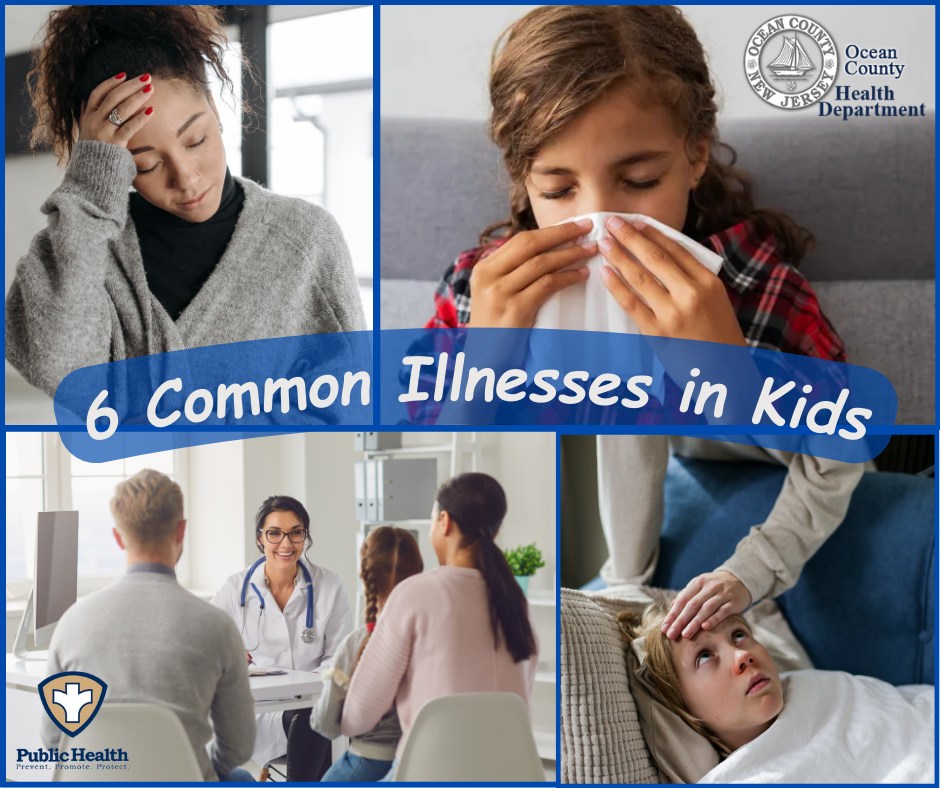
OCHD PROVIDES TIPS TO PROTECT YOUR KIDS
Respiratory syncytial virus, or RSV, is a common viral respiratory infection that, in children less than 2 years of age, causes bronchiolitis. Although different viruses can cause bronchiolitis, RSV is one of the most common causes, which means RSV can be serious in infants.
Symptoms of RSV include:
Cough
Runny nose
Fever
Upper airway congestion, such as nasal congestion and wheezing
Rapid breathing
In newborns during the first month of life, RSV can even cause apnea, which is an unexplained cessation or pause in breathing.
Symptoms of RSV typically start slowly over the first 1-2 days and worsen between days 3-7. RSV can last up to two weeks, though some kids will have symptoms for up to three weeks.
To help alleviate symptoms, parents can use a bulb syringe and saline drops to remove nasal fluids, provide plenty of fluids and try a vaporizer to help keep the air moist and make breathing easier.
2. Flu
Influenza, or the flu, is a very contagious respiratory virus. The onset of the flu is often sudden and associated with the following symptoms:
High fever (between 103-104°F)
Cough
Runny nose
Congestion
Muscle or body aches
Mild conjunctivitis (red or irritated eyes)
Possible vomiting/diarrhea in children
If symptoms of the flu are detected early, an antiviral medicine such as Tamiflu may be helpful. This medicine works best when given during the first 48 hours of symptoms. The flu vaccine is the best way to prevent the flu and to minimize complications.
3. Common cold
The common cold is a viral infection usually associated with more mild symptoms; however, children can have a low-grade fever early in the illness. Although colds seem to occur more often during the winter months, they can occur year-round. Many different viruses can cause a cold, which can last 5-14 days.
Symptoms of a common cold include:
Runny nose
Congestion
Cough
Sore throat
Fever
Vomiting and diarrhea usually don’t accompany a cold.
When a child has a common cold, providing comfort and support is important. Help your child stay hydrated and make sure they are getting plenty of rest. Cough and cold medications are not recommended for children under age 6.
4. Strep throat
Strep throat is a contagious bacterial infection that is more common during the fall, winter and early spring. It is especially common in children between the ages of 5 and 15.
Symptoms of strep throat can include:
Sore throat
Trouble swallowing
Fever
Stomach ache
Headache
A cough and runny nose do not accompany strep throat. A red rash can sometimes develop in kids with strep throat, resulting in a diagnosis of scarlet fever.
Strep throat can be easily and quickly treated with antibiotics. There are potential complications of strep throat such as throat abscess, retropharyngeal abscess, and rarely, rheumatic fever. If you suspect your child has strep throat, treatment is very important.
5. Stomach flu
Viral gastroenteritis is an intestinal infection that is often referred to as a stomach bug or the stomach flu. However, it is not related to the common flu or the influenza virus; it is most commonly caused by norovirus. Stomach viruses are very contagious and can cause severe symptoms that vary in duration. Typically, vomiting may last 1-2 days, but some GI symptoms can last up to one week.
Symptoms of viral gastroenteritis can include:
Vomiting
Watery diarrhea
Abdominal pain
Mild fever
Headache
Fatigue
These viruses develop quickly – usually within 12- 48 hours, so kids and parents should make sure they wash their hands thoroughly and often.
To help your child through the symptoms of stomach flu, parents should offer supportive care by providing plenty of fluids or ice chips and easy-to-digest foods. In severe cases, anti-diarrheal or anti-nausea medicine might be prescribed.
6. COVID‑19
COVID‑19 is a contagious respiratory illness that can cause a wide range of symptoms, including cough and fever. Children can get COVID‑19 at any time of the year, including the winter months. With highly contagious COVID‑19 variants spreading, it’s important to watch closely for symptoms and take steps to prevent infection.
It is not possible to tell the difference between COVID‑19 and a cold or upper respiratory infection without testing. Because of that, it is best to get tested if your child has any symptoms or was exposed to COVID‑19.
The best way to prevent COVID‑19 is for everyone who is eligible to get vaccinated. Washing hands frequently, wearing face masks and avoiding crowds can also help prevent the spread of illness.
Call your pediatrician if: Your child has a fever or chills, a cough, shortness of breath or difficulty breathing, fatigue, muscle or body aches, a headache, loss of taste or smell, a sore throat, congestion or runny nose, nausea/vomiting or diarrhea. Your child should tested for COVID‑19 if they are experiencing a combination of any of these symptoms, especially if they have been exposed to someone who has COVID‑19.
How to prevent getting sick in the winter
There are a few preventive measures you can help your kids practice to reduce the risk of winter illness. Dr. Lee recommends that kids:
Wash hands frequently
Stay up to date on vaccinations, including your annual flu vaccine and your COVID‑19 vaccine if eligible
Eat healthy foods and drink plenty of water
Get plenty of rest
Stay home if not feeling well to prevent germs from spreading
*Source: Children’s Health.com
